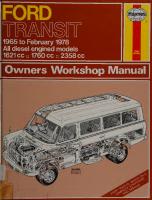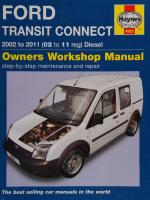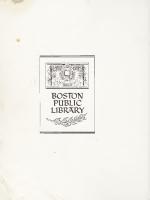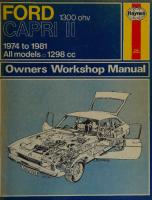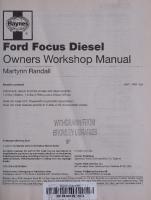Haynes Ford Transit Owners Workshop Manual 1850101760, 9781850101765
“276 pages : 28 cm Includes index 8551”.
129 87
English Pages 280 Year 1986
Recommend Papers
File loading please wait...
Citation preview
FORD TRANSIT 1978 to Jan 1986 □ All in-line engines 1599 cc ohv □ 1593 cc ohc □ 1993 cc ohc
Owners Workshop Manual
Ford T ransit Owners Workshop Manual I M Coomber Models covered All Ford Transit ('Mk 2') models with in-line petrol engines 1599cc ohv, 1593cc ohc & 1993cc ohc Does not cover Diesel or V6 petrol engines, non-standard bodywork and fittings, or Transit '86 models
(719-6T4)
Haynes Publishing Group Sparkford Nr Yeovil Somerset BA22 7JJ England Haynes Publications, Inc 861 Lawrence Drive Newbury Park California 91320 USA
Restoring and Preserving our Motoring Heritage Few people can have had the luck to realise their dreams to quite the same extent and in such a remarkable fashion as John Haynes, Founder and Chairman of the Haynes Publishing Group.
3-1
•
OR I b2-^-
2Tb
5141402 oot
Since 1965 his unique approach to workshop manual publishing has proved so successful that millions of Haynes Manuals are now sold every year throughout the world, covering literally thousands of different makes and models of cars, vans and motorcycles. A continuing passion for cars and motoring led to the founding in 1985 of a Charitable Trust dedicated to the restoration and preservation of our motoring heritage. To inaugurate the new Museum, John Haynes donated virtually his entire private collection of 52 cars. Now with an unrivalled international collection of over 210 veteran, vintage and classic cars and motorcycles, the Haynes Motor Museum in Somerset is well on the way to becoming one of the most interesting Motor Museums in the world.
Acknowledgements Thanks are due to the Champion Sparking Plug Company Limited, who supplied the illustrations showing spark plug conditions, to Holt Lloyd Limited who supplied the illustrations showing bodywork repair, and to Duckhams Oils, who provided lubrication data. Certain other illus¬ trations are the copyright of the Ford Motor Company, and are used with their permission. Thanks are also due to Sykes-Pickavant, who supplied some of the workshop tools, and to all the staff at Sparkford who assisted in the production of this manual. © Haynes Publishing Group 1991
A 70 seat video cinema, a cafe and an extensive motoring bookshop, together with a specially constructed one kilometre motor circuit, make a visit to the Haynes Motor Museum a truly unforgettable experience. Every vehicle in the museum is preserved in as near as possible mint condition and each car is run every six months on the motor circuit. Enjoy the picnic area set amongst the rolling Somerset hills. Peer through the William Morris workshop windows at cars being restored, and browse through the extensive displays of fascinating motoring memorabilia. From the 1903 Oldsmobile through such classics as an MG Midget to the mighty 'E' Type Jaguar, Lamborghini, Ferrari Berlinetta Boxer, and Graham Hill's Lola Cosworth, there is something for everyone, young and old alike, at this Somerset Museum.
A book in the Haynes Owners Workshop Manual Series Printed by J. H. Haynes & Co. Ltd., Sparkford, Nr Yeovil, Somerset BA22 7JJ, England All rights reserved. No part of this book may be reproduced or transmitted in any form or by any means, electronic or mechanical, including photocopying, recording or by any information storage or retrieval system, without permission in writing from the copyright holder.
ISBN 1 85010 176 0 British Library Cataloguing in Publication Data
Coomber, Ian Ford Transit (petrol) owners workshop manual. 2nd ed. - (Owners Workshop Manuals) 1. Ford Transit truck I. Title II. Series 629.2873 TL230.5.F57 ISBN 1-85010-176-0 Whilst every care is taken to ensure that the information in this manual is correct, no liability can be accepted by the authors or publishers for loss, damage or injury caused by any errors in, or omissions from, the information given.
Haynes Motor Museum Situated mid-way between London and Penzance, the Haynes MotorMuseum is located just off the A303 at Sparkford, Somerset (home of the Haynes Manual) and is open to the public 7 days a week all year round, except Christmas Day and Boxing Day.
Contents Page Acknowledgements
2
About this manual
5
Introduction to the Ford Transit
5
Buying spare parts and vehicle identification numbers
6
Tools and working facilities
7
Jacking and towing
9
Recommended lubricants and fluids
10
Safety first!
11
Routine maintenance
12
Fault diagnosis
14
General dimensions, weights and capacities
17
Chapter 1 Engine
18
Chapter 2 Cooling system
77
Chapter 3 Fuel and exhaust systems
83
Chapter 4 Ignition system
95
Chapter 5 Clutch
105
Chapter 6 Manual gearbox, overdrive and automatic transmission
110
Chapter 7 Propeller shaft
142
Chapter 8 Rear axle
144
Chapter 9 Braking system
151
Chapter 10 Electrical system
165
Chapter 11 Suspension and steering
202
Chapter 12 Bodywork and fittings
215
Chapter 13 Supplement: Revisions and information on later models
228
General repair procedures
264
Conversion factors
265
Index
Spark plug condition and bodywork repair colour pages between pages 32 and 33
266
Transit 100 Van
4
V >V
J
5
About this manual Its aim The aim of this manual is to help you get the best from your car. It can do so in several ways. It can help you decide what work must be done (even should you choose to get it done by a garage), provide information on routine maintenance and servicing, and give a logical course of action and diagnosis when random faults occur. However, it is hoped that you will use the manual by tackling the work yourself. On simpler jobs it may even be quicker than booking the car into a garage and going there twice to leave and collect it. Perhaps most important, a lot of money can be saved by avoiding the costs the garage must charge to cover its labour and overheads. The manual has drawings and descriptions to show the function of the various components so that their layout can be understood. Then the tasks are described and photographed in a step-by-step sequence so that even a novice can do the work.
Its arrangement The manual is divided into thirteen Chapters, each covering a logical sub-division of the vehicle. The Chapters are each divided into Sections, numbered with single figures, eg 5; and the Sections into paragraphs (or sub-sections), with decimal numbers following on from the Section they are in, eg 5.1. 5.2 etc.
It is freely illustrated, especially in those parts where there is a detailed sequence of operations to be carried out. There are two forms of illustration: figures and photographs. The figures are numbered in sequence with decimal numbers, according to their position in the Chapter - Fig. 6.4 is the fourth drawing/illustration in Chapter 6. Photographs carry the same number (either individually or in related groups) as the Section or sub-section to which they relate. There is an alphabetical index at the back of the manual as well as a contents list at the front. Each Chapter is also preceded by its own individual contents list. References to the 'left' or 'right' of the vehicle are in the sense of a person in the driver's seat facing forwards. Unless otherwise stated, nuts and bolts are removed by turning anti-clockwise, and tightened by turning clockwise. Vehicle manufacturers continually make changes to specifications and recommendations, and these, when notified, are incorporated into our manuals at the earliest opportunity. Whilst every care is taken to ensure that the information in this manual is correct, no liability can be accepted by the authors or publishers for loss, damage or injury caused by any errors in, or omissions from, the information given.
Introduction to the Ford Transit The 'new' Transit range of vehicles was introduced in 1978 and incorporated many improvements over its predecessor, both mechan¬ ical and aesthetic. The restyled front end allows more engine compart¬ ment workspace and is better aerodynamically than the earlier model. The dashboard has also been updated and has improved instrumenta¬ tion and controls. Various power units are available. Those covered by this manual are the 1.6 litre ohv Kent engine and the 1.6 and 2.0 litre ohc engine variants. Three transmission systems are available according to vehicle type, these being a four-speed manual gearbox, a four-speed manual gearbox with overdrive and a three-speed automatic transmission. The
manual gearboxes are available with standard or close ratio gears. The rear axle and differential are also variable to suit certain vehicle types. All models are now fitted with dual circuit servo-assisted brakes with discs at the front and self-adjusting drum brakes at the rear. Seemingly innumerable variations of body types and styles of Transit are available, from the humble Pick-up to the Caravanette. All body styles and variants are mounted on long or short wheelbase chassis as necessary. The Transit, given regular maintenance at the specified intervals, will give reliable service over a long period, and is therefore worth looking after.
6
Buying spare parts and vehicle identification numbers Buying spare parts Spare parts are available from many sources, for example: Ford garages, other garages and accessory shops, and motor factors. Our advice regarding spare part sources is as follows: Officially appointed Ford garages - This is the best source of parts which are peculiar to your vehicle and are otherwise not generally available (eg complete cylinder heads, internal gearbox components, badges, interior trim etc). It is also the only place at which you should buy parts if your vehicle is still under warranty - non-Ford components may invalidate the warranty. To be sure of obtaining the correct parts it will always be necessary to give the storeman your vehicle's identification number, and if possible, to take the 'old' part along for positive identification. Remember that many parts are available on a factory exchange scheme - any parts returned should always be clean! It obviously makes good sense to go straight to the specialists on your vehicle for this type of part for they are best equipped to supply you. Other garages and accessory shops — These are often very good places to buy materials and components needed for the maintenance of your vehicle (eg oil filters, spark plugs, bulbs, drivebelts, oil and greases, touch-up paint, filler paste etc). They also sell general accessories, usually have convenient opening hours, charge lower prices and can often be found not far from home. Motor factors - Good factors will stock all of the more important components which wear out relatively quickly (eg clutch components, pistons, valves, exhaust systems, brake cylinders/pipes/hoses/seals/ shoes and pads etc). Motor factors will often provide new or reconditioned components on a part exchange basis - this can save a considerable amount of money.
The vehicle identification plate is located in the cab footwell and lists the vehicle type and axle weight. The engine number on the ohv engine is located on the left-hand side of the crankcase towards the front. The engine number on the ohc engine is located on the right-hand side of the crankcase towards the front. •£ 2 0 d *^ ^ 0
0
>0 £
>0 ^ 0 05 0 ^
0
&
&
-0
.0.
0 >0
05 .0
0 .0 2 ^
0 0
°> S
V)
0
0
0
0
*0 o *0
0
£ £ 0 0 V) Co CO 0
0
0 -0
o
V)
CL
£ ^ hC 0: 0:
>0
0
* 3 c -c ■fe &>1s pi s > -S U ZJ
3
_to g _c .c .2> .S5 §
V
.2 2.9.222:® E'n)05DDj”(O D c2? o O^O)
2 S i2
NODroOr-Mn'jiDcoroOT-Mn
00 00 tS CD CD
Light blue
^ _l CC DC CD CD CD CD CD
LBL
tNCSJCMCNCNCNCNCNOOCOCOCO
CO
V o '-2 F >■ ro -F, o -* o £> c c ,E o o F ® u a>
ao co
.2 .2 £ ~ £ -Q D - 2 o D. t; o O W _ 'Z -p n 0 C (0 ioc^sSc lOC^^wu-mu. 2 J?< < £ 2 CD
tNco'^-LOcor-'Ooa)
r- (M CO ^ IfllD
CD
CD
-co
C
£ 2 2 2 2
-
-
V*
6
5
4
3
2
•
*/
0_|
r3!
1
TT
30.
M
ci
"U L 64-13
BL/BK-0.75
-50
BL/SW31-121
—
“
BK/Y-3,0 SW/GE -
64-13 BL/BK 0,75 BL/5W-15-5 BK/R-1.5-
-30-1
R-4,5
RT -
BR/G-1.5 -
HR
v
r
."
m -30-5
R-1,5
RT-61
-60
BL-0,75
BK/Y-3,0 SW/GE -16-2
-54-15
BL/G-0.76
-54-13
BL/BK 0,75
&
r
o
Fig. 13.31A Charging, starting and ignition circuit
BK 1,6 SW-
HB/GN-54-14
m
HB-
BL/SW-
R/W-0,75
RT/WS-
245
Fig, 13.31A Charging, starting and ignition circuit (continued)
V.
/
Fig. 13.31 B Exterior lights circuit
r
247
Fig. 13.31 B Exterior lights circuit (continued)
248
©
Fig. 13.31 C Interior lights circuit
Alternative arrangements shown
249
G_R 6
5
IT
4
3
2
1
O
TT
\ -60
o
FT
BK/Y-3,0 SW/GE-
.J^"**^|m D
RT
-f
R-4.5
©
Fig. 13.31 C Interior lights circuit (continued)
250
Fig. 13.31 D Horn, indicators and hazard lights circuit
V,
r
251
Fig. 13.31 D Horn, indicators and hazard lights circuit (continued)
Fig. 13.31 E Heater, wiper and exterior lights circuit
253
..■•>."•
.-...r"-v
.....
..;.... "
...■.:.:
•50
BK/Y-3.0 SW/GE
'
Fig. 13.31 E Heater, wiper and exterior lights circuit (continued)
V
J
LBL/BK
Fig. 13.32 Wiring diagram: overdrive - all models
254
©
V
255
if) oc
7
(D
C q Q)
(/-) LLI
u
_ P*
r
n
Sg? = £ * P°- 5 25^.0 D)q-0C'-' > C
..
0
>~ r~
-^ 0 >
r~
v __
^ .IP
O
€
®
2 £ ,g>.g>.E ® .2
C3C3_i_iQ.tr>>>^ CD C3 _ C3C3-J_JQ-Cr>>>-
OQ

